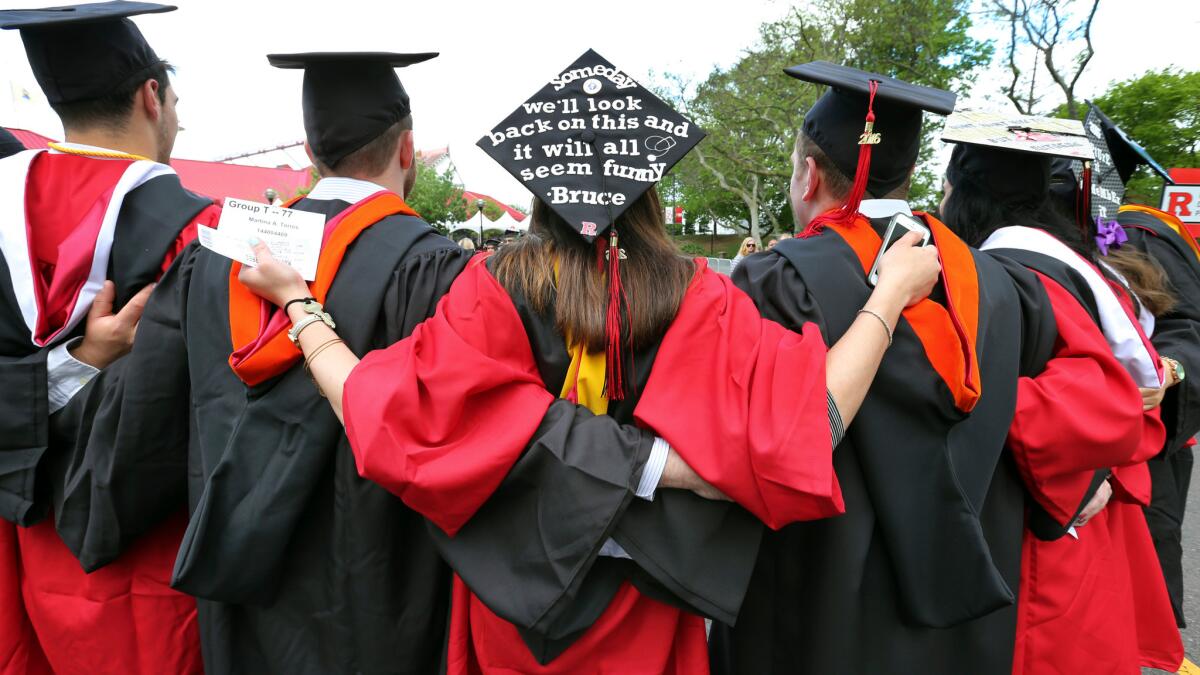Op-Ed: Rule for student debt forgiveness could threaten colleges and spur lawsuits

- Share via
In the wake of the collapse of the Corinthian Colleges and questions about other for-profit career colleges, the Department of Education has drafted broad new rules for when people can get out of repaying federal loans. These proposed changes to what’s called the “borrower defense rule” would let people petition for loan forgiveness or even sue their school.
The problem is the proposed rules, which will be finalized by Nov. 1, are so vague they may invite abuse and lawsuits. For example, student borrowers could apply to discharge their loans if the college made statements that were “misleading under the circumstances.” What does that mean exactly? Who knows? Department of Education employees and courts will get to decide on a case-by-case basis, apparently.
These poorly devised standards [are likely to] spur new lawsuits.
More troublesome is that these poorly devised standards likely would spur new lawsuits. Indeed, the proposed regulations expressly contemplate students suing their schools: One of the major proposed changes outlaws binding arbitration as a means of resolving disputes. Instead, students could either file an administrative petition asking the Department of Education to cancel their debt, or file a lawsuit against their school (or perhaps both). Indeed, the proposed regulations seek to protect the use of class action lawsuits against colleges.
Students have a tremendous incentive to try to get out of paying for their education. More than two-thirds of college graduates carry student loans with an average debt of almost $35,000 — more for graduate students. Many will struggle to keep up with payments, especially in their first jobs. You can bet plenty will try to take advantage of this rule change.
As long as a college did not mislead prospective or current students about, say, graduation or job placement rates, or the cost of tuition, it should not have to worry, right? Hard to say. The old standard required proving that the school deceived students, and it referred to state law requirements for misrepresentation.
The newly proposed standard, “mislead,” is intentionally broader than “misrepresent.” It includes affirmative statements, but also failure to disclose something that the student can argue influenced their decision to enroll or to continue at the college. That could be just about anything and a “borrowers defense” can be raised any time before a loan is paid off.
California colleges should be worried. Claremont McKenna, for instance, is among a handful of colleges that admitted reporting inflated average SAT scores during the 2000s, hoping to influence the annual U.S. News & World Report college rankings.
Other schools have employed more creative methods. In 2008, Texas’ Baylor University offered $300 in bookstore credits to any incoming student who’d retake the SAT — and if their score went up 50 points they were given a $1,000 scholarship. Baylor got a 10-point average SAT score bump out of the deal. Leaders at UC Irvine Law School also had their eye on cracking the top 20 in their initial U.S. News ranking when they gave their entire inaugural class full three-year scholarships. The offer was designed to attract top students who’d otherwise pass on applying to a brand new law school. The problem? Subsequent classes didn’t get the same deal, so the school cannot guarantee it would maintain a student body of that caliber.
Are such ranking-rigging strategies misleading? A student with significant debt will certainly be tempted to make the argument.
This is not the only area of risk. A number of California colleges, including UCLA and UC San Diego, have been criticized for inaccurately reporting campus crime rates. A 2014 investigative report by the Columbus Dispatch concluded that: “The crime statistics being released by colleges nationwide… are so misleading that they give students and parents a false sense of security.” Is this misleading enough for a student to sue?
It is also not hard to imagine that different standards might emerge in every state where lawsuits are filed.
No court judgments, however, would be binding on the Department of Education. Even if a judge determines a case is meritless, department officials might still wipe out a student’s loan debt. These officials would be given complete discretion to decide whether a school is guilty of “misleading under the circumstances” statements. The Department of Education would then demand the school reimburse the government for all the forgiven loans. There is no procedure for the college to challenge those rulings.
Instead of protecting students from predatory or even fraudulent programs, the proposed new regulations would just spawn litigation and create substantial costs for colleges and universities. Those costs would be passed on to students. Rather than solve a problem, the Department of Education’s rules look to be a lose-lose proposition for all parties.
Anthony T. Caso is a professor at Chapman University’s Fowler School of Law and the director of the Claremont Institute’s Constitutional Jurisprudence Clinic.
To read the article in Spanish, click here
Follow the Opinion section on Twitter @latimesopinion and Facebook
More to Read
A cure for the common opinion
Get thought-provoking perspectives with our weekly newsletter.
You may occasionally receive promotional content from the Los Angeles Times.










